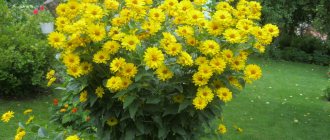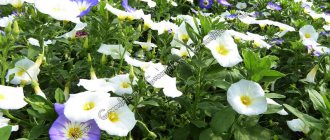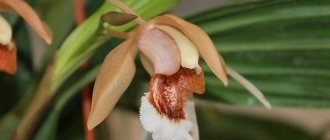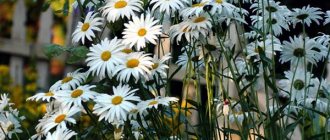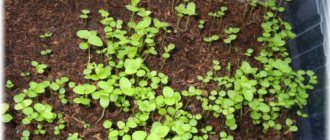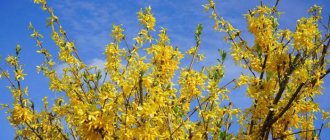Features of growing cornflower
The simplicity and elegance of the cornflower, or simply daisy, fascinates and does not leave flower growers indifferent.
Many varieties of this magnificent plant can give the site a unique look. By adhering to the simple rules of growing cornflowers, you will get strong and abundantly blooming sun daisies, which, in combination with poppies, cornflowers and bluebells, are ideal for creating a small, cozy country-style garden.
Nivyaniki are perennial and annual rhizomatous herbaceous plants of the Asteraceae or Compositae family. Their leaves are entire with serrated edges, and the inflorescences can be of various shapes and have a white or yellow color.
Description of terry chamomile
The herbaceous plant belongs to the Asteraceae (Asteraceae) family. Terry chamomile is popularly called cornflower. The name is not always correct, since there is a separate variety of terry chamomile - Nivyanik.
Terry chamomile is a decorative perennial with large double inflorescences.
The stem is thick, elastic and dark green, reaching a length of 30 to 100 cm. The buds are large and dense.
The time of inflorescence depends on the variety. On average, it starts in June and ends in October. Inflorescence 8-12 cm in diameter.
Double chamomile flowers look similar to chrysanthemums, but are not chrysanthemums. They can be soft or dense to the touch. Although there is information in several sources that nivaria is classified as one of the types of chrysanthemums. The information has not been officially confirmed in biological encyclopedias.
Interesting! A priori, double chamomile flowers are snow-white; flowers of rare varieties come in cream, milky, and chalky shades.
Flowers are suitable for bouquets - they retain freshness for a long time, exude a pleasant and slightly perceptible aroma, and look lush and beautiful, especially when combined with bright accents.
Nivyanik, planting and care
Also popular is the Common Nivianik, which is distinguished by the exceptional size of its inflorescences and their high decorative value.
Nivyanka Maximum is a perennial plant (a complete encyclopedia of perennials can be viewed here). Its numerous hybrids can reach a height of more than a meter. Among the non-terry varieties, the following are popular: Alaska, Silver Princess and Everst. Their unusually large inflorescences, up to 8 cm in diameter, with white petals and a yellow center, look like a classic chamomile. These forms are characterized by a height of no more than 70 cm.
Popular varieties of cornflower
Garden daisies are represented by more than 70 varieties, among which the following gorgeous species are worth noting:
- Nivyanik Grand Illusion. Proper planting and care of this perennial will allow you to grow a branched bush up to 1 m high. The inflorescences are large, 10-12 cm in diameter, white.
- Cornflower variety Crazy Daisy. A bush up to 70 cm high with small, maximum 8 cm in diameter, baskets. But they are terry, with thin petals.
- Nivianik grandiflora Giant. One of the largest daisies. Bush up to 80 cm high with strong stems and large baskets up to 12 cm in diameter.
- The variety of cornflower is magnificent Broadway Lights. A low bush up to 50 cm tall with delicate yellow daisies.
- Magnificent cornflower Fiona Goghill. The bush is 60 cm high, the inflorescences are densely double, with a filled core. At the same time, the petals become longer and longer closer to the edge of the basket.
Planting and care
Wild cornflowers prefer to grow in open, sunny places. It is also better to place their garden forms in illuminated areas, since in the shade these plants develop poorly and lose their decorative properties. The soil for planting garden chamomile should be fertile and well permeable. The ideal option would be black soil. The plant will not grow on loam, clay and sandy soils.
Do not plant in places where water can accumulate in the spring, since stagnation of moisture leads to rotting of the rhizome and the plant may die. In the summer heat, it is worth making sure that the soil in which the nevus is grown does not dry out. These plants are very sensitive to lack of moisture, but when overwatered or kept on excessively damp soils, they are susceptible to fungal diseases.
Since these perennials are herbaceous plants, only their rhizomes overwinter. It is better to hill up terry, semi-double and hybrid varieties and cover them with a layer of mulch or foliage for the winter. Simple daisies will overwinter without additional insulation. Dry branches must be pruned so that in the spring they do not interfere with the growth of new shoots and do not spoil the flower garden with their unsightly appearance. At the beginning of April, the shelter must be removed. After the appearance of young shoots, you can periodically apply fertilizer. Any organic fertilizer would be an excellent option.
Tall daisies are placed at a distance of 50-70 cm from each other. It is better to plant low-growing ones 15-20 cm apart from each other. It must be taken into account that every year the bush will grow in width, doubling in volume per season.
After flowering ends, the decorative effect of the plant is lost. It is better to prune, leaving no more than 15 cm from the base of the stems.
Characteristics of terry chamomile varieties
Among the abundance of types of terry chamomile, varieties that have their own individual characteristics are especially popular.
French chamomile
The plant is one of the most winter-hardy among the orders of the Astrov family.
It loves moist soil and is planted in open ground. The inflorescence is 11 cm. A distinctive feature is that it blooms from May until the onset of frost.
Daisy Goldfinch
The variety has golden, double flowers with narrow, dissected petals. Blooms from early June until the first frost (mid-October). The height of the bush is about 50 cm. It tolerates the lack of light especially poorly. Looks good in group plantings.
Chamomile Nivyanik
Another name is Crazy Daisy chamomile. The stem grows around 70 cm. The petals of Crazy Daisy are elongated, dissected, and soft. The flowers are snow-white, chrysanthemum-like in shape. It grows on loose soils and requires a lot of light and space. Loves feeding. In May, it is recommended to first plant in a greenhouse, and in June - in open ground.
Chamomile Chrysanthemum
The variety is distinguished by a large single inflorescence. Diameter – 12 cm. Petals are soft to the touch, fragile. The plant is winter-hardy and does not require much light.
Chamomile Edelweiss
It is considered the flower of true love and happiness. The scientific name is Leontopodium. Tolerates severe frosts. The flowering period ranges from early June to late August. The appearance of the inflorescence resembles a lush lion's paw. Loves moist soils and does not require much light.
Chamomile Fiona Goghill
A densely double, pom-pom-like plant. Diameter – 8 cm. Height – about 50 cm. Blooms from early June to August. For normal development of chamomile, fertile soil, well moistened, is required. Loves fertilizers and top dressing.
Chamomile Fiona Goghill
Romashka Real Knight
The flowers are spoon-shaped (narrow in the middle, widening towards the edges). Arranged in 2 or 3 rows. The stems are massive, length – about 40 cm.
Romashka Real Knight
They are not winter hardy, but have increased disease resistance. Blooms in July. Feels good in open sunny areas.
Chamomile Little Lady
Reaches only 15 cm in height.
Chamomile Real Glory
Plant height – 75 cm. The marginal flowers are pure white, the tubular ones are pale yellow. Flowers with a diameter of 11 cm. Long flowering begins in June and lasts until the end of October. Has increased resistance to diseases and pests.
Chamomile Real Glory
Reproduction
Most hybrids can reproduce in two ways - by dividing the bush and by seeds. The first option is quite simple, but requires compliance with several rules: only those rhizomes that have reached a sufficiently large size can be divided. This usually happens after 3-4 years of growing nibbles in one place.
In the spring, when the active growth stage begins, the flowers are dug up and the rhizomes are carefully separated into several parts. You should not leave too small parts, as their viability is quite low.
Growing cornflower from seeds does not always give the desired result, since hybrid varieties do not retain the shape and decorativeness of the mother plant. If you want to try sowing cornflower seeds, then you need to collect them in early September. It is best to sow them for seedlings in open ground before winter. However, sowing in the spring at home gives equally good results. Grown seedlings dive at the stage of formation of 3-4 true leaves, and after the threat of night frosts has passed, they are moved to open ground to a permanent place.
Did you like the article? Vote! 11111 Rating 5.00
How to care for large chamomile in spring (before flowering)
Immediately after removing the cover from the cornflower, I sprinkle urea along the rows at the rate of 20 grams (a matchbox) per linear meter of planting. The soil after covering is quite moist and the urea gradually dissolves and is absorbed into the soil without additional watering.
This first feeding is necessary for plants, since garden chamomile very rapidly gains green mass before flowering. I apply the second similar feeding as needed - I determine it by the appearance of the plants. If the trunks and leaves of the nivberry are dark green in color and the plant develops normally, then there is a sufficient amount of nutrients in the soil - there is no need for fertilizing. If the color becomes pale green, or even worse, yellowish, then the daisies need feeding.
During the period of garden chamomile growth until flowering, I usually apply two or three fertilizing treatments. The use of urea leads to acidification of the soil. To avoid this, I alternate fertilizing with mineral fertilizers with fertilizing with a solution of fresh mullein or an infusion of bird droppings. In addition to the necessary nitrogen fertilizer, such fertilizing also provides the plants with much-needed microelements.
During the formation of a bud on the trunk of a giant chamomile, stepsons sprout in the axils of the leaves. To get a large main flower, the stepsons need to be broken out in a timely manner. This procedure must be performed several times, preventing the stepsons from growing back. The first to grow are the stepsons closest to the main bud. As the plant grows, lower shoots gradually sprout.
Quite often, aphids appear on garden chamomile under the developing bud. Until the bud opens, the flowers can be treated with any drug against this pest. If aphids appear only on certain flowers, then I easily wash them off with a stream of water when watering the plants.
Description Perennial chamomile Fiona
Chamomile / Nielberry Fiona (Fiona) is one of the most luxurious varieties of our collection. Its lush, densely double flowers, more like chrysanthemums, will become a true decoration of flower beds.
Features of the variety:
- The height of the Fiona chamomile (Fiona) is up to 90 cm.
- When the bud is half-opened, the rosette is rather flat, but in full bloom it becomes lush like a classic chrysanthemum.
- The diameter of the flowers is up to 12 cm.
- The middle is soft yellow-greenish.
- Near the edge of the flower, the white petals are wide and elongated. Closer to the center - they become narrower, slightly concave along; towards the middle - the small petals acquire a yellowish-greenish tint, forming the middle.
Description and main characteristics of Fiona chamomile:
- The diameter of the opened buds can reach 15 cm, but you need to take good care of them.
- The plant is fast-growing, large, flower stalks can reach 100 cm or more with good feeding.
- The color of the flowers is traditional, but the shape is very unusual for daisies.
- Tall powerful stems hold heavy terry buds well.
- Winter hardiness - overwinters without additional shelter.
- Flowering is long-lasting, up to 55 days.
- Care is simple, but it is advisable to feed it so that the flowers are even larger.
- Landing sites are protected from the wind and sunny.
Chamomile Fiona (Fiona) is a double, spectacular Dutch variety. In the online store Jaskrava Klumba there is a collection of seedlings of different varieties of daisies that can be bought at a reasonable price. Delivery by mail – throughout Ukraine (Kyiv, Sumy, Rivne, Chernivtsi, Odessa, etc.)
Decorative chamomile is a very unpretentious and spectacular flower. Three years ago I planted two small bushes. They grew quickly and turned out to be completely unpretentious to care for. Now I have several types of multi-colored daisies growing: white, yellow, red - a real decoration of my site.
Overwintering large chamomile (nivery) in open ground
In general, wintering of adult large chamomile plants takes place without any problems. But this, of course, is only true for our area - central Ukraine. The most severe frosts recorded over the past two decades reached -27. But such frosts here are very short-lived, lasting no more than two or three days.
As a rule, with the arrival of such frosts, snow fell. Therefore, for flowers wintering in the open ground, including the giant chamomile (nivberry), these frosts are not terrible.
However, there were winters when the first December frosts, as they say, “fell” on the bare ground, not covered with snow. Although these frosts were not too severe (no lower than -10), they lasted a week, or even two. These situations are dangerous for young plants. With prolonged exposure to even mild frosts, young chamomile plantings can freeze. Therefore, plantations of large daisies planted last season must be covered before the arrival of frost.
It is better to play it safe and cover all daisy plantings with at least a small layer of foliage. Even if the situation I described above does not happen, and frost does not fall on the bare ground, you will have peace of mind that your young plants will not freeze.
Previously, I covered all the giant chamomile plantings for the winter - both old and new. Moreover, he covered it with a rather thick layer of foliage. But over time, I noticed that for old plantings, a symbolic shelter for the winter is enough - a very small layer of leaves. And some cornflowers, which for one reason or another were left without shelter at all, also overwintered well.
You can use either garden foliage or any other foliage to cover daisies for the winter. We have a lot of poplar trees, so I always took fallen leaves from these trees. You can take from the trees that grow in your area.
Partner news
Nivyanik - growing from seeds
In this material we will talk about cornflower and its cultivation from seeds. It is unlikely that there is at least one gardener who would not know what the nevus looks like, because its second name is garden chamomile. This flower is very popular among gardeners, because it blooms beautifully and is especially unpretentious in terms of care and planting location. But still, in order to grow chamomile in all its glory, you need to have some knowledge.
General information
The nivberry flower (garden chamomile) is a plant that is resistant to negative temperatures. The culture belongs to the extensive family of Asteraceae. The stem of this flower can reach a height of up to one meter (depending on the variety chosen for sowing).
Control of diseases and pests of neviberry
If there are errors in care, the nevus can get sick. Common lesions, their signs, therapeutic and preventive measures:
| Maxima Koenig. | Diameter 8-12 cm. May-July. | |||
| May Queen. | Semi-double. Late spring-early August. | |||
| San Souci. | Large, terry, lemony in the center. Second decade of summer. | |||
| Largest | Grows up to 1 m. A distinctive feature is late flowering. | Basal, dark green, crenate. Large, simple, terry. | Alaska. | 10 cm. From early July to late autumn. |
| Snow Lady. | With a lush center, wide petals. From the 2nd month of summer until the first frost. | |||
| Little Princess. | Simple. From late June to October. | |||
| Crazy-Daisy. | Looks like a chrysanthemum. July-end of September. | |||
| Broadway Lights. | Simple, soft amber. From the 2nd decade of summer to mid-autumn. | |||
| Mayfield. | They grow in 2 rows, snow-white, reed-shaped. July-September. | |||
| Silver Princess. | Simple. From the end of June to October. | |||
| Wirral Supreme. | Semi-double. From early July until frost. | |||
| Snow White. | Densely double, collected in baskets. From mid-summer until the end of the season. | |||
| Fabulous | With strong stems, up to 1 m in height. | At the base they are collected into sockets. Long, up to 30 cm. Terry, from yellowish-green to creamy-pink in color. | Fiona Goghill. | Petals are light beige. The core is lush, canary-colored. June July. |
| Spring giant. | Large, simple, snow-white. Mid-summer-October. | |||
| Grand Illusion. | Collected in baskets. June July. |
| Diseases | Manifestation on leaves | Prevention and remedies |
| Mosaic is a viral infection. |
|
|
| Soft bacterial rot (infection occurs through the soil or affected plants). |
|
|
| Ramulariasis. |
|
|
| Septoria |
|
|
| Root rot. |
| Before planting, place in Trichodermin or Alirin-B solution. |
| Pests | ||
| Chrysanthemum leaf miners (larvae of flies and moths). |
|
|
| Thrips. |
|
|
| Pennitsy. |
|
|
| Aphid. |
|
|
